Back
- Applications
- Products
- Support
- About HiSilicon
No Result
 Dec 08, 2021
Dec 08, 2021[Shanghai, China, Dec 8, 2021] As the Internet of Things (IoT) moves ever closer to an all-connected future, data collection demands for IoT devices and new access technologies continue to soar. The last mile of IoT networks will bring improvements in reliability, security, and effectiveness, and that's where PLC-IoT comes into the picture.
Overview of PLC-IoT
Power line communication (PLC) reuses power lines as communications lines that connect IoT devices. Since there is no extra wiring involved, PLC is able to avoid issues related to as tangled cables, aging, and maintenance. Meanwhile, when compared with wireless communications, PLC is more resistant to its surroundings, such as walls and interference from the 2.4 GHz unlicensed band. Better yet, PLC greatly reduces costs by allowing for one network to be shared among a wide range of different communication technologies. Thanks to the power grid, the world's widest network, data communications via power lines becomes remarkably easy, even in the most remote locations, laying the groundwork for an all-connected future.
PLC-IoT is a new paradigm for PLC technology. It's compliant with HPLC/IEEE 1901.1, and features mid-band power-line carrier communications in the IoT domain, resolving the issues of signal interference from power lines and attenuation, while also supporting IP-based communications. By reusing power lines, PLC-IoT saves the time and labor required to dig trenches and bury cables, slashing construction and deployment costs by more than 50%. The high-speed, reliable IoT networks on the device side have been used in a broad range of contexts, including smart homes, smart metering, smart traffic lighting, smart street lamps, and photovoltaic (PV) power generation.
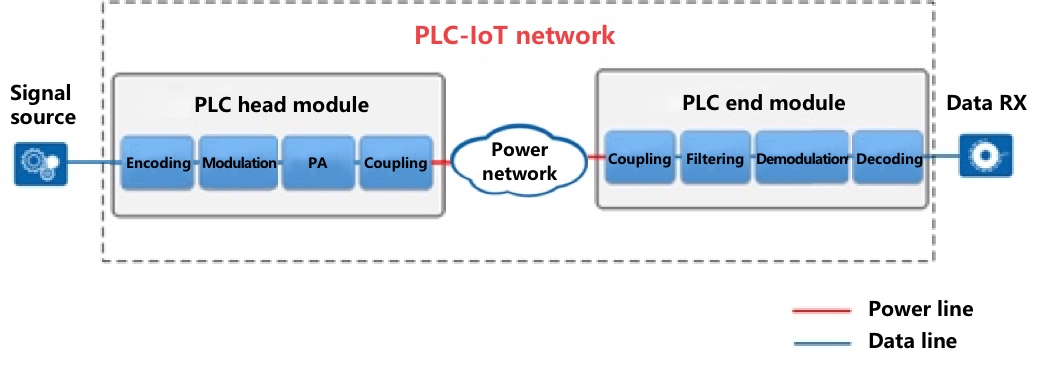
PLC-IoT schematic diagram
The Ideal Standard for PLC-IoT
IEEE standards for PLC are classified into IEEE 1901, IEEE 1901.1, and IEEE 1901.2. IEEE 1901 is a standard for in-home broadband modems; IEEE 1901.1 and 1901.2 are low- and mid-frequency IoT standards.
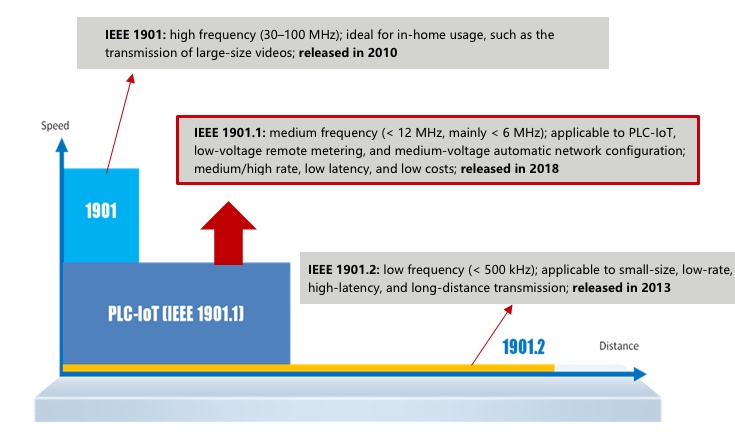
IEEE standards for PLC

Comparison to PLC standards
To sum up, IEEE 1901.1 features high rates, fast networking, low band noise, and low attenuation, making it broadly applicable to IoT environments with strong interference. HiSilicon PLC-IoT complies with IEEE 1901.1, meeting the requirements for medium/high rates, low latency, and hassle-free O&M.
PLC-IoT Unrivaled as a Wired Connectivity Solution

PLC-IoT substantially outperforms KNX

PLC-IoT greatly outperforms Zigbee
Generally speaking, PLC-IoT comes with significant advantages in terms of engineering costs, since it requires no extra cabling. It also excels in terms of transmission distance and speed, compared with traditional technologies, which ensures that connections are consistently robust.
Advantages of HiSilicon PLC-IoT
1. Stable: Supports continual operation for more than 20,000 hours
The core virtues of the HiSilicon PLC chipset solution are that it resolves noise and attenuation-related issues, thereby ensuring stable communications. Thanks to a massive power line noise database, HiSilicon is capable of performing simulation modeling and testing for models in its PLC lab. HiSilicon's solution has set a record for continual operation of more than 4 years, as demonstrated in a host of lab environments, including those involving environments characterized by high temperatures, high humidity, high altitude, and extreme coldness and aridity.
Performance in home environments:
Powerful penetration through walls: Seamless control from up to 1000 m away for any layout
High stability: Low latency and 100% success rate
Strong interference avoidance: Immune to interference from the 2.4 GHz band, effectively isolates
power-line noise
2. Reliable: Low latency and fast response
Reliable solution design:
Noise isolation: Isolates noise from different networks and its surroundings by using isolators.
Network isolation: Isolates networks by using isolators or trustlists.
Reliable chipset design:
• 1.6–6 MHz band: This band avoids noise in bands lower than 1 MHz, and attenuation in bands higher than
10 MHz in most scenarios.
• Band adaptation: Multi-stage filters are utilized to filter out out-of-band noise, and work with the
band adaptation function to automatically adjust filter parameters to ensure the optimal cutoff frequency.
• Effective anti-noise and anti-attenuation technologies: The following channel characteristics of power
lines are designed based on analysis of massive amounts of test data. In the time domain, real-time
impulse noise detection and elimination algorithms are introduced to deal with noise variation down to
microsecond level. In the frequency domain, narrowband noise detection and elimination algorithms are
used for strong single-frequency or colored noise signals. Multi-subcarrier transmission works in
parallel, divides each band into several different sub-channels, which further boosts anti-noise and
anti-attenuation capabilities.
• Low latency: Quality of service (QoS) is supported to ensure that high-priority packets are transmitted
first.
• Error detection and correction: Data retransmission and conflict avoidance are allowed.
3. Simple: Effortless installation and maintenance
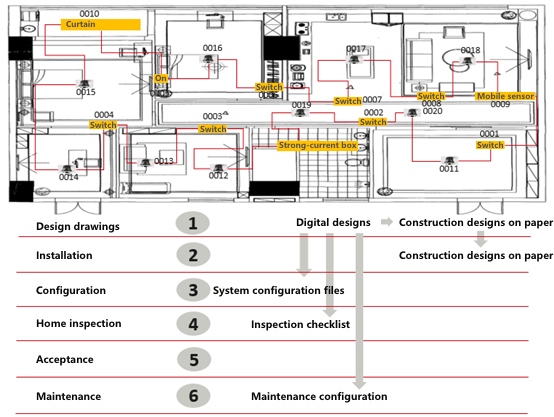
Cable routing diagram
Design phase: PLC devices are arranged in as few circuit loops as possible.
Installation phase: Installation is so easy that it can be performed solely by electricians. It involves
no software or network configurations, as PLC devices are automatically networked.
Acceptance phase: Electricians are able to complete acceptance according to the scenario and circuit
design, without requiring the assistance of designers.
Maintenance phase: Devices can be directly replaced, and automatically networked upon power-on. It is not
necessary to consider the interference from wireless devices to the PLC devices. This phase also does not
require the assistance of any designers.
4. Fast: Automatic networking, for instantaneous communications
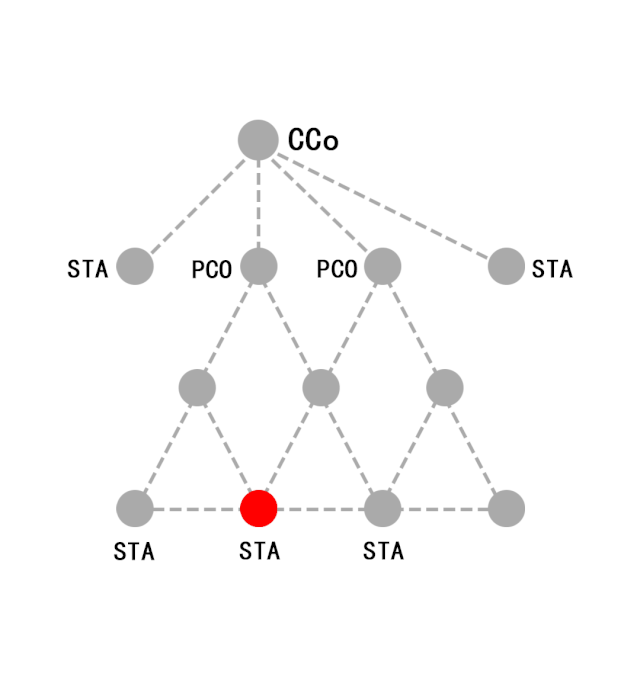
Tree topology in networking
CCO: concentrator
STA: station
PCO: proxy coordinator
Flexible networking mode: (1) Tree networking, in which the CCO functions as the parent node, and the STA functions as the child nodes. An STA becomes a PCO if it is a proxy station. All STAs send network access requests to the CCO, and are allowed to join the network upon the approval of the CCO. Once the network is established, PLC communications is feasible between the CCO and STAs. STAs are not able to directly communicate with each other, and therefore need the CCO to perform signal forwarding. (2) Mesh networking: No CCO exists. Each STA also serves as a PCO. STAs directly communicate with each other. Automatic networking mode: For a 500-node, 2-layer network, 10s is all it takes to complete networking upon the initial power-on. A single node can access the network in milliseconds upon power-on. This mode applies to such scenarios as power-on, power-off, replacement, and removal of a single device. Dynamic routing and multipath addressing are also supported.
Diverse PLC-IoT Applications
1. Smart home

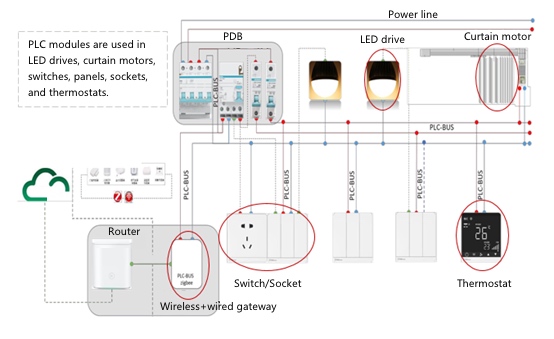
PLC-IoT in a smart home
Effortless: Streamlined installation and deployment
Cost-effective: Low costs, thanks to the streamlined design, lack of cabling, easy maintenance, and
reduced need for designers
Reliable: Free of wireless co-channel interference, strong signal penetration through walls, and
isolation between households, each of which features dozens to hundreds of PLC nodes
2. Lighting

Commercial lighting: PLC can be integrated in the LED drivers of track lights or magnetic lights. The
drivers are powered by DC supplies, and multiple DC circuits form a network. The PLC gateway is powered by an AC
supply.
Street lighting: A street lighting system consists of a master station, concentrators, and street lamp
controllers. The concentrators are installed in the power distribution cabinets of the street lamps, and the
controllers are installed inside the buried section of the lamp poles.
Industrial lighting: PLC-IoT is ideal for scenarios with multiple noise sources and strong interference,
such as industrial and mining areas, power grids, and oil fields, where the installation and working environment
for lights is extremely complex.
3. Air conditioning

Stable: Air conditioners usually use independent circuits, which ensures isolation, reduces noise, and
avoids wireless co-channel interference.
Straightforward: Zero labor is required for cabling and network configuration. With external PLC modules,
only a minimal amount of adjustment to MCU software and air conditioner tests is required.
Swift: The speed of networking is fast, due to the limited number of nodes. (A central air conditioner
allows for a maximum number of 64 internal units connected to 1 external unit.)
4. PV power generation

AC-DC communications: Inverters communicate with optimizers (installed on PV modules) via PLC, for
real-time status monitoring, so that the DC power generated by the PV modules can be better converted into AC
power.
Low-cost solution: It's affordable to apply, due to the easy deployment and maintenance process.
Responsive: With 500 network nodes at most, networking can be completed within seconds upon startup, and
optimizers can be shut down within a second.
This site uses cookies. By continuing to browse the site you are agreeing to our use of cookies. Read our privacy policy